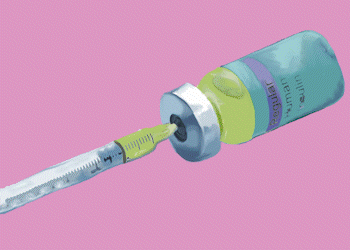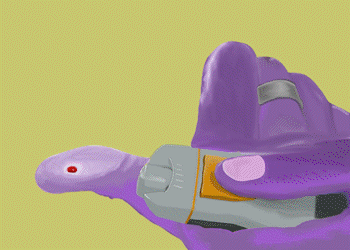No more insulin injections? Maybe someday
In very early trials, stem cell treatments for Type 1 diabetes yield encouraging results and raise the possibility of an eventual cure for millions
Maiya Focht • January 10, 2022

People with Type 1 diabetes have to check their blood sugar before and after every meal so that they know how much insulin to inject. [Credit: Maiya Focht]
If you think it’s a breeze having Type 1 diabetes, take a walk in Jane Bloom Wallsworth’s sneakers. Interviewed while on her daily stroll through her Kansas neighborhood, Wallsworth recalls her lows: the time she almost passed out in a car ride home with her husband, or when she was found unconscious on her kitchen floor after she uncharacteristically missed a morning of work.
She can tick off the details of her elaborate diabetes regimen with ease. Jane gives herself anywhere from three to nine insulin injections a day, exactly 20 minutes before every meal. She has to be vigilant, though, since special snacks or even just a glass of wine can throw off her careful calculations.
So when she heard about a new stem cell treatment that might someday allow her to reduce or even forego insulin injections, effectively curing her diabetes, she couldn’t help being excited by the possibility — and not just for her own sake.
”It would change my life. I can’t even imagine. And in particular, it would change children’s lives,” she says. About 200,000 of the 1.6 million Americans living with Type 1 diabetes — almost 13% — are children, and many of them struggle to manage their condition. It’s hard enough to get kids to eat their vegetables, never mind balance every intake of food.
The stem cell treatment is still years away from being widely available, as it takes a long time to get therapies of this sort through the necessary approval. But in October the company behind it, Vertex Pharmaceuticals, announced significant results in an early-stage trial on a single patient. Ninety days after researchers placed the insulin-producing stem cells into the patient, he had reduced his exterior insulin needs by 91%.
Vertex’s experimental therapy uses stem cells that are reverse-engineered from the diabetes patients’ own cells. Once those cells are treated in the lab and begin producing insulin, they are injected back into the patient’s body, where they land in the damaged pancreas and produce insulin on their own, according to company spokeswoman Heather Nichols. A competing company, ViaCyte, is working on a similar therapy on a similar timeline, and recently announced positive, although very early, results.
If either treatment works in larger trials and is ultimately approved by the U.S. Food and Drug Administration, a process that will take several more years at least, it could dramatically ease the daily strain on Type 1 diabetes patients, according to Dr. Jay Skyler, a diabetes specialist at the University of Miami who is not involved with either company.
The next big question, Skyler says, is how long the stem cells will keep producing insulin after being transplanted, and whether they will be as effective in a large sample of patients with the disease. For now, he advises, diabetics and their families hoping for a cure should understand that, “These are really exciting, potentially promising results that give hope, but we shouldn’t hype them as having really achieved things yet. There are still many steps to go.”
“Hype and hope differ by one letter,” says Skyler.
While the more common Type 2 diabetes typically develops later in life, Type 1 diabetics are usually diagnosed before adulthood. That’s why the condition is often called juvenile diabetes. In these patients, insulin-producing beta cells in the pancreas are damaged or inactivated, allowing sugar to build up in the bloodstream instead of being transported to cells for energy. This buildup can cause a host of symptoms ranging from nerve damage to limb loss to kidney problems.
Insulin injections have been standard therapy for diabetics for almost a century. Newly diagnosed diabetics usually start with two injections per day but have to add more as time goes on, according to the American Diabetes Association. The amount of insulin required can vary depending on the patient’s diet and condition.
Those injections can add up. Wallsworth, the Kansas patient, says it feels like she has to inject herself “a gazillion times” per week. Adding something to your daily life that requires careful thought and measurement can become tiring, although Wallsworth says she’s had to adjust to it.
There is another, less common treatment method, too. In a severe enough case, a person with Type 1 diabetes may be eligible for beta-cell transplant or even a whole pancreas transplant, says Skyler. The transplants then supply healthy insulin-producing cells to replace the dysfunctional ones. Currently, however, only a small percentage of people with the disease meet the criteria for a transplant because the supply of pancreases is so low that they can only go to the people in most desperate need.
Skyler says the inclusion criteria for Vertex’s experimental therapy are similarly strict, which means that the only patients who currently qualify for the stem cell trials are those who might otherwise need a donated pancreas for transplant surgery.
But if Vertex’s therapy progresses and the inclusion criteria are broadened, more patients could eventually be eligible. “If you had an unlimited source of cells, and you didn’t need rejection medicines, and they lasted a reasonable period of time, the real hope is that that could actually be a treatment for everybody with Type 1 diabetes,” says Skyler.
Those rejection medicines are another major limitation of both pancreas transplants and Vertex’s experimental therapy. Even though the treated cells originate from their own body, the patient has to take immunosuppressant drugs to make sure their immune system doesn’t flag the re-injected stem cells as dangerous and attack them, says Esther Latres, a biochemist at the Juvenile Diabetes Research Foundation, which has been a major funder of diabetic stem cell research.
Immunosuppressive drugs can leave patients vulnerable to other infections, including viruses like COVID-19, Latres says. Vertex and ViaCyte are both currently exploring technology to circumvent the need for these drugs by encasing transplanted cells in a coating that disguises them from the body, says Latres.

Blood sugar is commonly monitored by devices like these, called glucometers, which are able to detect amounts of sugar within a sample of blood. [Credit: Maiya Focht]
A key difference between the two competing treatments is that ViaCyte relies on human embryonic stem cells, while Vertex uses a different type of stem cell made from adult cells. Neither is necessarily more effective, but because some groups object to the use of embryonic stem cells on ethical grounds, the type made from adult cells is generally more accessible.
Experts aren’t sure how much either stem cell therapy would ultimately cost at this early stage. But the current injection-dependent treatment regimen for Type 1 diabetes costs about $2,500 per year for an insured person, says pediatric endocrinologist Dr. Joyce Lee of the University of Michigan, who has studied the issue. “The out-of-pocket costs for uninsured patients,” she says, “is potentially much larger.”
Insulin accounts for 18% of that annual spending, although the Biden Administration is trying to convince Congress to take steps to cut those costs. If a drug like Vertex’s eliminated the need for any insulin at all, that could save patients money over the long term, even if the stem cell treatments are expensive, says Lee.
With or without cost savings, the quality of life improvements for Type 1 diabetes patients could be immense if Vertex achieves its ultimate goal of “a one-time functional cure,” as company spokeswoman Nichols puts it. For now, the company is focusing on recruiting a larger group of participants for a phase 2 trial.
ViaCyte, meanwhile, is moving through similar early trials. In its first trial, a patient was able to cut their insulin intake by 69% according to Dr. Howard Foyt, ViaCyte’s chief medical officer. The company has also been approved for a phase 1 trial in Canada in which it will try to address the immunosuppressant problem by using the gene-editing tool CRISPR to create stem cells undetectable to the immune system.
While these trials make their way through the approval process, diabetics like Jane Bloom Wallsworth are hoping for the best. As a mother herself, she is grateful that her own child doesn’t share her condition. But she knows all too well how challenging the disease is to manage for adults, much less children. “If you are a parent of a child with this, it’s difficult to control what they’re eating and that would be very difficult. With my life, I’m in charge of me so you know, it’s okay,” she says.